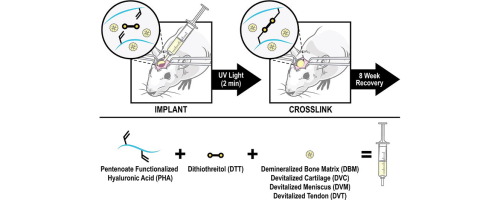Acta Biomaterialia ( IF 9.4 ) Pub Date : 2018-03-01 , DOI: 10.1016/j.actbio.2018.02.013 Jakob M Townsend 1 , Brian T Andrews 2 , Yi Feng 3 , Jinxi Wang 3 , Randolph J Nudo 4 , Erik Van Kampen 5 , Stevin H Gehrke 5 , Cory J Berkland 6 , Michael S Detamore 1

|
Traumatic brain injury (TBI) is a life-threatening condition defined by internal brain herniation. Severe TBI is commonly treated by a two-stage surgical intervention, where decompressive craniectomy is first conducted to remove a large portion of calvarial bone and allow unimpeded brain swelling. In the second surgery, spaced weeks to months after the first, cranioplasty is performed to restore the cranial bone. Hydrogels with paste-like precursor solutions for surgical placement may potentially revolutionize TBI treatment by permitting a single-stage surgical intervention, capable of being implanted with the initial surgery, remaining pliable during brain swelling, and tuned to regenerate calvarial bone after brain swelling has subsided. The current study evaluated the use of photocrosslinkable pentenoate-functionalized hyaluronic acid (PHA) and non-crosslinking hyaluronic acid (HA) hydrogels encapsulating naturally derived tissue particles of demineralized bone matrix (DBM), devitalized cartilage (DVC), devitalized meniscus (DVM), or devitalized tendon (DVT) for bone regeneration in critical-size rat calvarial defects. All hydrogel precursors exhibited a yield stress for placement and addition of particles increased the average material compressive modulus. The HA-DBM (4-30%), PHA (4%), and PHA-DVT (4-30%) groups had 5 (p < 0.0001), 3.1, and 3.2 (p < 0.05) times greater regenerated bone volume compared to the sham (untreated defect) group, respectively. In vitro cell studies suggested that the PHA-DVT (4-10%) group would have the most desirable performance. Overall, hydrogels containing DVT particles outperformed other materials in terms of bone regeneration in vivo and calcium deposition in vitro. Hydrogels containing DVT will be further evaluated in future rat TBI studies.
Statement of Significance
Traumatic brain injury (TBI) is a life-threatening condition characterized by severe brain swelling and is currently treated by a two-stage surgical procedure. Complications associated with the two-stage surgical intervention include the occurrence of the condition termed syndrome of the trephined; however, the condition is completely reversible once the secondary surgery is performed. A desirable TBI treatment would include a single surgical intervention to avoid syndrome of the trephined altogether. The first hurdle in reaching the overall goal is to develop a pliable hydrogel material which can regenerate the patient’s bone. The development of a pliable hydrogel technology would greatly impact the field of bone regeneration for TBI application and other areas of bone regeneration.
中文翻译:

使用戊烯酸酯官能化的透明质酸水凝胶和失活的肌腱颗粒,实现出色的颅骨再生。
脑外伤(TBI)是由内部脑疝定义的危及生命的疾病。严重的TBI通常通过两阶段的外科手术治疗,其中首先进行减压颅骨切除术,以去除大部分颅骨骨并允许其不受肿胀的脑肿胀。在第二次手术中,在第一次手术后间隔几周到几个月不等,进行颅骨成形术以恢复颅骨。具有糊状前体溶液以进行手术放置的水凝胶可能会通过允许单阶段手术干预而进行TBI治疗,从而可以彻底改变TBI的治疗方法,该手术能够植入初始手术中,在脑肿胀期间保持柔韧性,并调整为在脑肿胀消退后再生颅盖骨。 。当前的研究评估了使用光交联的戊烯酸酯官能化的透明质酸(PHA)和非交联的透明质酸(HA)水凝胶的使用,该水凝胶包封了脱矿质骨基质(DBM),失活软骨(DVC),失活半月板(DVM)的天然来源组织或失活的肌腱(DVT),用于在关键尺寸的大鼠颅骨缺损中进行骨再生。所有水凝胶前体均表现出屈服应力,且颗粒的添加增加了平均材料的压缩模量。HA-DBM(4-30%),PHA(4%)和PHA-DVT(4-30%)组的再生骨量增加了5倍(p <0.0001),3.1和3.2(p <0.05)分别与假(未治疗的缺损)组进行比较。所有水凝胶前体均表现出屈服应力,且颗粒的添加增加了平均材料的压缩模量。HA-DBM(4-30%),PHA(4%)和PHA-DVT(4-30%)组的再生骨量增加了5倍(p <0.0001),3.1和3.2(p <0.05)分别与假(未治疗的缺损)组进行比较。所有水凝胶前体均表现出屈服应力,且颗粒的添加增加了平均材料的压缩模量。HA-DBM(4-30%),PHA(4%)和PHA-DVT(4-30%)组的再生骨量增加了5倍(p <0.0001),3.1和3.2(p <0.05)分别与假(未治疗的缺损)组进行比较。体外细胞研究表明,PHA-DVT(4-10%)组将具有最理想的性能。总体而言,就体内的骨再生和体外的钙沉积而言,含有DVT颗粒的水凝胶的性能优于其他材料。含有DVT的水凝胶将在未来的大鼠TBI研究中进一步评估。
重要声明
颅脑外伤(TBI)是一种威胁生命的疾病,其特征是脑部严重肿胀,目前正通过两阶段外科手术进行治疗。与两阶段手术干预相关的并发症包括发生所谓的三叉神经综合征的症状。但是,一旦进行了二次手术,这种情况就完全可以逆转了。理想的TBI治疗将包括单一手术干预,以免完全避免综合症。达到总体目标的第一个障碍是开发一种柔软的水凝胶材料,该材料可以使患者的骨骼再生。柔韧水凝胶技术的发展将极大地影响TBI应用的骨再生领域和其他骨再生领域。











































 京公网安备 11010802027423号
京公网安备 11010802027423号